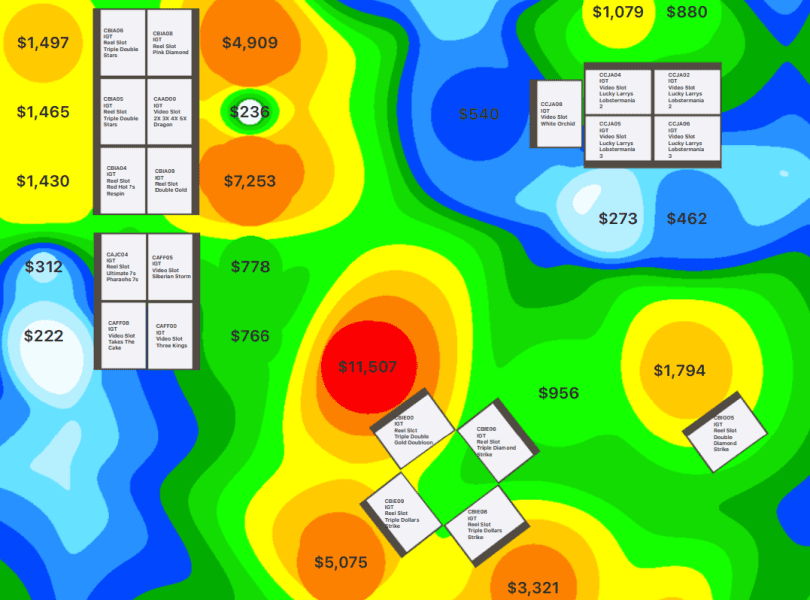With ChatGPT and “deep fakes” generating negative headlines, AI or artificial intelligence has been in the news quite a bit recently. Some are calling for emergency actions to put regulatory limits on the technology, perhaps recalling the 1984 classic movie “Terminator” where murderous cyborgs created by the AI-network known as Skynet aim to dominate mankind.
However, the current reality may be a lot less scary and prove remarkably helpful. Just this month the Washington Post, in an article entitled “A curious person’s guide to artificial intelligence” noted, “for decades AI has largely been used for analysis, allowing people to spot patterns and make predictions by assessing huge sets of data.”
Of course, all that data could be abused with AI cranking out phony student term papers or replicating familiar voices to promote phone scams. But it can make, and has made, many of our slot floors more profitable, and more enjoyable for our players.
While you may mistakenly think that AI is the latest thing, data scientists, as mentioned above, have been using it for decades to solve complex problems from astronomy to tracking containers on shipping docks. Perhaps surprising to some, few problems are as complex as truly optimizing a slot floor. What is new is that AI technology is getting better and faster. And that is providing sharper insights.
The historical approach to slot floor optimization from the 1950s to the mid ‘90s was quite simple and taught in every Slots 101 class: “Add more games that have a high Win Per Unit Per Day (WPU) and get rid of the ones that don’t.” That axiom was somewhat reborn during the recent pandemic when many operators reduced the number of games and saw their WPU go up on several slot products.
Andrew Cardno has been analyzing slot floors with AI tools since 1999 and using mapping and large data sets for years before that. He founded Compudigm at that time, and later developed Viz Explorer with mathematician Dr. Ralph Thomas. Last year, they co-founded Quick Custom Intelligence (QCI) to take advantage of the latest technology.
Today, Cardno almost sounds like an evangelizing preacher on the subject of the mis-use of “WPU.” “The metric that you’re optimizing is a metric that actually reduces the revenue of your casino. It may be that you actually want a lower theoretical win per unit per day. You want to lower it because that lowers occupancy. Lower is better.”
Without some of that complex math from QCI and AI, that concept sounds bizarre. In an article first published in 2010, Cardno and Thomas wrote, “Adding a second variable – utilization – changes the picture completely.[1]”
But why would you possibly want slot occupancy to be lower?? In a recent interview Cardno explained, “It improves having more availability. It’s counterintuitive. Like the revenue per machine per day going down is normally a good thing. It means that you’re contending to a wider market. It means you’ve got other products in there that different kinds of customers want to play. It means that your occupancy is going down. It means you’ve got enough products for people at peak times. You won’t have that when you reduce game counts. That’s what the outcome of a properly optimized floor will be. Your overall revenue will go up, your revenue per machine on some machines may go down.”
From the days of drop buckets, WPU has always been available to operators. But with analytical software, occupancy can now be calculated by looking at carded-play patterns. The variance or error rates between those using cards and not using cards can also be measured (it is generally very similar). Using both WPU and occupancy together begins the process of optimization.
But Cardno and Thomas say there are two other critical factors that play an important role. However, they require some serious database horsepower: “location” and “devotion.”
Referencing Slots 101, it’s well established that games on the end of a bank do better than those in the middle. Likewise, casino legends say games near the entrances, bathrooms and restaurants might also do well. Cardno added in their 2010 article that, “the best measure of the effect of location is to compare the performance of a gaming device to the performance of adjacent games.
“One powerful method of calculating the value of a location is to combine the effect of gravity modeling and spatial association rules.” That requires some heavy math but can be made easier to comprehend by visually mapping your floor using heat-like signatures and contouring with color codes to fine tune optimization and location. With that method, you can quickly see the relative value of any machine and the ones that surround it.

Even more complex, and the strongest case for the power of the new AI, is a devotion index. “Which games you take off, that can be the harder part,” according to Cardno, “because when taking off your lowest performing games, you might have some old, what we call, ‘keynote’ games. When you take them off, you’re going to lose those keynote players. Compare that to a supermarket without bananas. If you remove them, you’re not going to have any banana shoppers. They are going to go to another store that has bananas.” He says that is what will happen at your casino if you remove the wrong games. The keynote players who like the removed machines are going to go somewhere else to find their games. They were the ones “devoted” to bananas in the example above.
 Cardno calls devotion, “a measure of the ‘market basket.’ It’s a measure of determining what products are in a group of products that are played together, or said another way, products typically played as a group. We give that an index. So, a high devotion index means that those customers who play on those products don’t play on other games. They just play on their products with high devotion indexes.”
Cardno calls devotion, “a measure of the ‘market basket.’ It’s a measure of determining what products are in a group of products that are played together, or said another way, products typically played as a group. We give that an index. So, a high devotion index means that those customers who play on those products don’t play on other games. They just play on their products with high devotion indexes.”
Wikipedia says the market basket concept is used in many forms of retail and financial analysis. They define it as, “a distinct concept in data mining involving the analysis of items frequently purchased together.” And this is where Cardno and other researchers see the benefits of new AI programs like ChatGPT.
Earlier this month CNN reported from London, “A basket of stocks selected by ChatGPT, a chatbot powered by artificial intelligence (AI), has far outperformed some of the most popular investment funds in the United Kingdom.” Many of these same types of AI analysis are being used by Thomas and Cardno to refine their “devotion” scores and produce even better player “market baskets” of slots.
As this new artificial intelligence technology gets stronger and stronger, there can be reason for concern about abuse and fraud. But at the same time, our ability to optimize our slot floors to increase player satisfaction and generate higher profitability will also get better and better.
[1] The article, “An Analyst’s Guide to Slot Floor Optimization” was reprinted in the 4th edition of the “Math That Gaming Made” by Cardno, Thomas and A.K. Singh released earlier in 2023.




